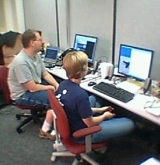Learning Powerful Kicks on the Aibo ERS-7: The Quest for a Striker
Learning Powerful Kicks on the Aibo ERS-7: The Quest for a Striker.
Matthew
Hausknecht and Peter Stone.
In Javier
Ruiz-del-Solar, Eric Chown, and Paul G. Plöger, editors, RoboCup-2010: Robot Soccer World Cup XIV, Lecture
Notes in Artificial Intelligence, pp. 254–65, Springer Verlag, Berlin, 2011.
Video and source code available at
http://www.cs.utexas.edu/~AustinVilla/?p=research/aibo_kick
Download
[PDF]324.4kB [postscript]2.8MB
Abstract
Coordinating complex motion sequences remains a challenging task for robotics. Machine Learning has aided this process, successfully improving motion sequences such as walking and grasping. However, to the best of our knowledge, outside of simulation, learning has never been applied to the task of kicking the ball. We apply machine learning methods to optimize kick power entirely on a real robot. The resulting learned kick is significantly more powerful than the most powerful hand-coded kick of one of the most successful RoboCup four-legged league teams, and is learned in a principled manner which requires very little engineering of the parameter space. Finally, model inversion is applied to the problem of creating a parameterized kick capable of kicking the ball a specified distance.
BibTeX Entry
@incollection{LNAI10-hausknecht,
author = "Matthew Hausknecht and Peter Stone",
title = "Learning Powerful Kicks on the Aibo ERS-7: The Quest for a Striker",
booktitle= "{R}obo{C}up-2010: Robot Soccer World Cup {XIV}",
Editor={Javier Ruiz-del-Solar and Eric Chown and Paul G. Pl\"oger},
Publisher="Springer Verlag",
address="Berlin",
year="2011",
series="Lecture Notes in Artificial Intelligence",
volume="6556",
pages="254--65",
abstract = {
Coordinating complex motion sequences remains a challenging task for
robotics. Machine Learning has aided this process, successfully
improving motion sequences such as walking and grasping. However, to
the best of our knowledge, outside of simulation, learning has never
been applied to the task of kicking the ball. We apply machine
learning methods to optimize kick power entirely on a real robot. The
resulting learned kick is significantly more powerful than the most
powerful hand-coded kick of one of the most successful RoboCup
four-legged league teams, and is learned in a principled manner which
requires very little engineering of the parameter space. Finally,
model inversion is applied to the problem of creating a parameterized
kick capable of kicking the ball a specified distance.
},
}



